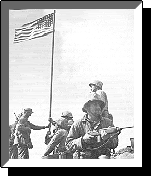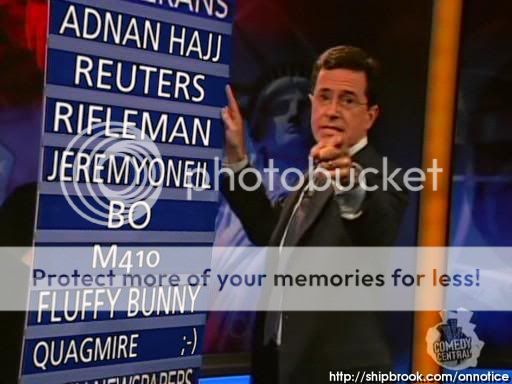LGF Exclusive: How Much Does It Cost to Buy Global TV News?
An LGF reader who worked for Associated Press TV News sent me the following article explaining how APTN works, and suggesting a reason why their coverage of the Middle East is so overwhelmingly biased against Israel:
How Much Does It Cost to Buy Global TV News?
The vast majority of the TV news pictures you see are produced by two TV news companies. Presented here is a case for how a large amount of money has been used to inject a clear bias into the heart of the global TV news gathering system. That this happens is not at question, whether it is by accident or design is harder to tell.
You may not realize it, but if you watch any TV news broadcast on any station anywhere in the world, there is a better than even chance you will view pictures from APTN. BBC, Fox, Sky, CNN and every major broadcaster subscribes to and uses APTN pictures. While the method by which they operate is interesting, it is the extra service this US owned and UK based company offers to Arab states that is really interesting.
About the Associated Press
The Associated Press (AP) is a not-for-profit news gathering and dissemination service based in the US.Formed in 1848, the AP grew up from an agreement between the six major New York newspapers of the day. They wanted to defray the large telegraphy costs that they were all independently incurring for sending the same news coast to coast. Despite being highly competitive, they formed the Associated Press as a collection agency and agreed to share the material. Today, that six-newspaper cooperative is an organization serving more than 1,500 newspapers and 5,000 broadcast outlets in the United States. Abroad, AP services are printed and broadcast in 112 countries.
Associated Press Television News
Associated Press Television News (APTN) is a wholly owned subsidiary of AP. It was formally set up as a separate entity in 1994. It is run as a commercial entity and aims to make a profit. Any profit it does make is fed back to AP (which is non-profit making: APTN profits reduce the newsgathering costs incurred by the 1500 US newspapers that collectively own the AP). APTN is the largest television news gathering player (larger than Reuters, its only true competitor in this field). While AP is based in the US, APTN operates out of large premises in Camden, London. They have news teams, offices and broadcast facilities in just about every important place in the world.
APTN uses news crews and broadcast facilities all over the world to record video of newsworthy events (in News, Sport and Entertainment). These pictures are either sent unedited or very partially edited back to London. Most news is fed back within hours but they also cover and feed certain events live (news conferences in Iraq, press conferences after a sporting event etc.). Most of these stories are sent in with “natural sound”: there is no journalist providing a voice over, but the choice of what to shoot is in the hands of the local producer and camera crew. Local crews are sometimes employed directly by APTN, or more often “stringers” are hired for a particular event or paid for the footage they have already captured.
Once the stories have been fed back to the UK they are edited. This is a round the clock operation. The goal is to produce a 30 minute news bulletin comprising 6 or 7 stories every few hours. These stories are made by editing down the raw “rushes” that come in from all over the world. This is done by a team of producers who work for the news editor. They don’t supply a voice over but they do edit, discard and sequence pictures dictating the emphasis and direction of the story. They will accompany each story with a written description of each shot and the general reason this was a story. This is repeated for News, Sport & Entertainment with a geographical emphasis that shifts around the world as different markets wake and sleep. The output of this is called the “Global News Wire” (GNW).
The Business of TV News
This is how APTN makes its money: news organizations (mostly TV but not all) subscribe to APTN and pay an annual amount to both watch and then re-use the stories that are fed over the GNW. The stories are supplied with sound, but no journalist to do a voice over. Most commercial news stations (like the BBC, SKY, Fox or CNN) would take this feed, decide which pictures to use then re-edit it and supply an appropriate voice over for the story. The video comes with a written description of the shots and the events that occur in them.
The fee for this feed depends on the size of the receiving organization, their audience size and a negotiation with APTN’s sales force. It is pretty much impossible, however, to operate a TV news organization without taking feeds from either APTN or Reuters or usually both. The agreement with APTN usually allows the receiving news channel unlimited use of the video for two weeks. If they want to re-show those pictures after that they have to separately license the pictures (which can cost anything from $100 to $10,000 per 30 seconds depending on the content).
A Separate Service for Arab States
However, there is another significant part of their business model that affects the rest of the business. While most of the world takes news pictures with minimal interpretation beyond editing, the Arab Gulf States have asked for and receive a different and far more expensive service. These states pay for a complete news report service including full editing and voice overs from known journalists. The news organizations in the Arab countries don’t do anything (beyond verify that they are appropriate for local tastes) before broadcast.
What this means is that while there are around 50 people producing news pictures for the whole world working in Camden at any time, there are a further 50 Arabic speaking staff producing finished stories exclusively for the Arab states of the gulf. This has a tremendous effect on the whole feel of the building as these two teams feed pictures and people back and forth and sit in adjacent work areas. The slant of the stories required by the Gulf States has a definite effect on which footage is used and discarded. This affects both the Gulf newsroom and the main global newsroom.
This full service feed is much more expensive for the customers than the usual service, but it is also much higher margin for APTN. This is partly because there is great commonality in what they can send to most of the Gulf States taking this service: stories are made once and used in a number of countries.
Disproportionately Negative Coverage of Israel
Anything involving Israel is a favorite with Gulf Arab states for showing to their viewers. Could this be the reason why Israel receives such a disproportionate amount of particularly negative coverage especially and increasingly ever since the early 1970’s? HonestReporting is usually unable to decide which is most biased: AP or BBC. As the BBC is often using APTN footage, the difference is minor. A significant twist to what is seen, concerns what is not seen. Footage such as the Palestinian mob joyfully lynching two Israeli reservists in Ramallah in October 2000 is held by APTN’s library: any attempt to license this film for reshow is carefully vetted. Requests for the use of “sensitive clips” are referred directly to the Library director. This is not the case with clips that paint Israel in a bad light. Likewise, the re-showing of Palestinian celebrations on 9/11 is considered “sensitive”.
The way in which raw footage such as APTN’s is compiled into a news report and sent round the world has also been analyzed. The Second Draft gives a comprehensive view of how editing can make all the difference. APTN is the gatekeeper that sits between you and the actual event. You will never see what the editors at APTN see before they compile your evening news. What do you think is cut out?
The Wrap-Up
Was this organization set up with this in-built bias on purpose? Is there some way that the expensive payments made by Gulf state governments form part of a deliberate attempt to skew the media?
In “Islam and Dhimmitude” (2002) by Bat Ye’or on p294-296 she recounts how decisions were taken in the wake of the Arab-Israeli war of 1967 to try to put across an anti-Jewish, anti-Zionist message. Successive conferences resolved to contribute vast sums “to universities, centers for Islamic studies, international communications agencies, and private and governmental organizations in order to win over world opinion.” (p296).
The messages from these conferences stressed an addition to the more familiar violent jihad: they also emphasized the importance of jihad by the written and spoken word—what we would recognize as classic propaganda. Without question APTN’s interesting business model represents a concrete example of an ongoing financial “contribution” to an important communication agency promoting a pro-Arab bias.



